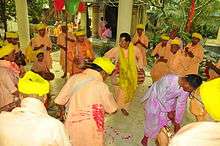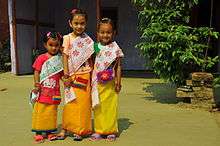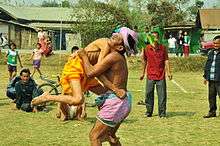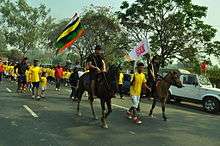Yaosang


Yaosang is a festival celebrated in Manipur for five days in spring, starting on the full moon day of the month of Lamda (February–March). Yaosang combines Hindu and indigenous traditions of the Meitei people.[1] It is identified with the festival of Holi and is considered the most important festival in Manipur.[2] Like Holi, the Hindu Meitei of Manipur play with colours during this festival.
Yaosang begins just after sunset in every village with the Yaosang Mei thaba, or Burning of the Straw Hut. Then the children ask at every house for monetary donations, called nakatheng. On the second day, groups of local bands perform sankirtan in the Govindagee Temple in the Imphal-East district of Manipur. On the second and third days, girls go to their relatives for their nakatheng and block roads with ropes for collecting money. On the fourth and fifth days, people pour or splash water on one another.
Another feature of this festival is Thabal Chongba (Dancing in the Moonlight). Males from various places will come to the site of the festival and dance in circles with the females, holding their hands. In 2016, this occurred March 23-24.[3]
The locals also engage in feasting to celebrate this festival of merrymaking. Of late, there has been a trend of channelling the festive energy toward sporting events to spot out talents at the grassroot level, which is in line with the rich sporting spirit of the Meiteis.
Sports

The most important aspect of Yaosang is the five-day-long sports festival in every nook and corner of the state. This is the most remarkable difference between the Holi festival in Manipur and other parts of the country.

On the first day of Yaosang, local clubs organize and visit the sacred Kangla Fort for lighting of the torch to inaugurate the sports meet. The sports consist primarily of games which are easy to play and fun to watch, like spoon racing, mathematical racing, tug of war, soccer and many others. On the last day, however, every club usually organizes a half marathon, which is a part of the festival never to be missed.
References
- Sanajaoba, Naorem (1988). Manipur, Past and Present: The Heritage and Ordeals of a Civilization, Volume 4. New Delhi: Mittal Publications. ISBN 9788170998532.
- ↑ Singh, Ksh Imokanta (2008). Religion and Development in North-east India: A sociological understanding (PDF). Religions and Development Research Programme. University of Birmingham. p. 76. ISBN 0 7044 2655 2. Retrieved 18 June 2015.
However, rather than starting a completely new religious system, their efforts have focused on establishing a parallel culture to counter the Vaisnavite forces, for example observance of Yaosang (Meitei version of Holi) during the same period as the Hindu Holi festival. This movement may try to create a political fissure within the society, but it is very difficult to sort out which elements are purely Hindu and which indigenous, because people have long internalized both elements in their way of life.
- ↑ Parratt, Saroj Nalini (April 1974). "The Public Festivals". The Religion of Manipur: Beliefs, Rituals and Historical Development (PDF) (Thesis). Australian National University. p. 43. Retrieved 18 June 2015.
The third, and most important, of the Krishnaite festivals is Holi, or, to give it its Meitei name, Yaosang. This is the greatest of the Meitei festivals and is celebrated on the full moon of Lamda (FebruaryMarch), lasting for six days.
- ↑ http://manipur.gov.in/wp-content/uploads/2013/02/general_holiday_2016.pdf